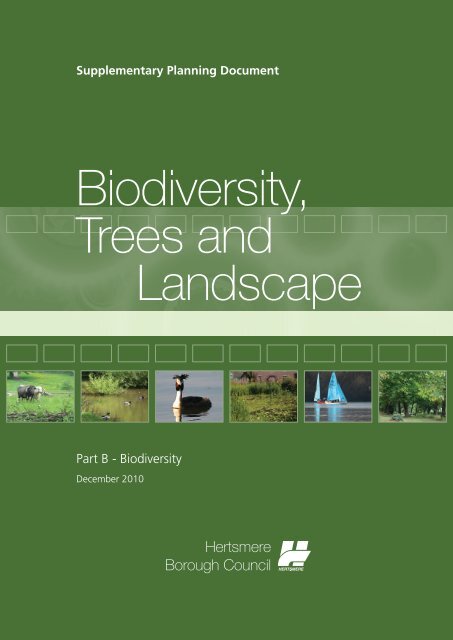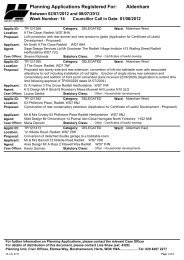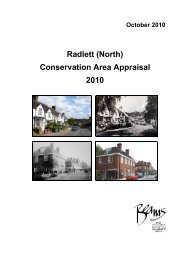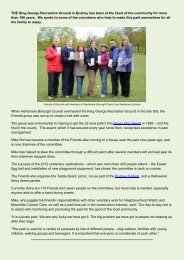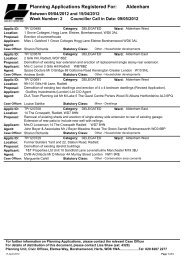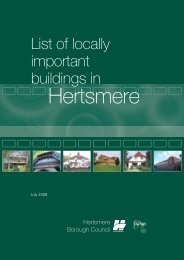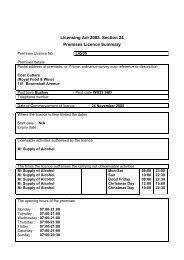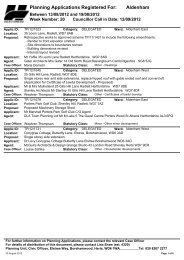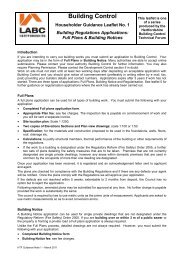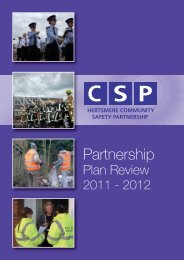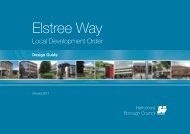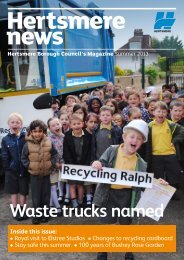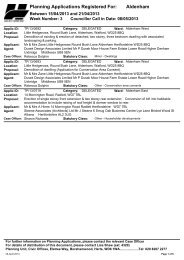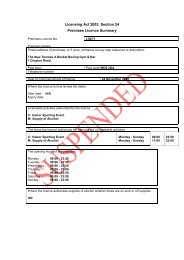Biodiversity - Hertsmere Borough Council
Biodiversity - Hertsmere Borough Council
Biodiversity - Hertsmere Borough Council
You also want an ePaper? Increase the reach of your titles
YUMPU automatically turns print PDFs into web optimized ePapers that Google loves.
Supplementary Planning Document<br />
<strong>Biodiversity</strong>,<br />
Trees and<br />
Landscape<br />
Part B - <strong>Biodiversity</strong><br />
December 2010<br />
<strong>Hertsmere</strong><br />
<strong>Borough</strong> <strong>Council</strong>
Large print and languages<br />
<strong>Hertsmere</strong> <strong>Borough</strong> <strong>Council</strong> aims to<br />
provide information in alternative<br />
formats where possible.<br />
If you would like a document in a<br />
different language or format please<br />
call 020 8207 7445 or email<br />
customer.services@hertsmere.gov.uk<br />
and we will do our best to help.<br />
Please allow sufficient time for any<br />
document to be translated.
<strong>Hertsmere</strong> <strong>Borough</strong> <strong>Council</strong> - <strong>Biodiversity</strong>, Trees and Landscape<br />
Contents<br />
1. <strong>Biodiversity</strong>............................................................................................................................3<br />
2. Delivery of biodiversity objectives through the planning system ............................................4<br />
3. Physical characteristics of <strong>Hertsmere</strong>......................................................................................7<br />
4. Sites of ecological importance ..............................................................................................8<br />
5. Habitat resources in <strong>Hertsmere</strong>............................................................................................10<br />
Woodland ..............................................................................................................................10<br />
Grassland ................................................................................................................................11<br />
Heathland ..............................................................................................................................13<br />
Wetland ..................................................................................................................................14<br />
Artificial ..................................................................................................................................15<br />
Orchards ................................................................................................................................15<br />
6. Protected species and species of interest ..................................................................................16<br />
Badgers ..................................................................................................................................16<br />
Bats ........................................................................................................................................17<br />
Reptiles and Amphibians ........................................................................................................18<br />
Water Voles ............................................................................................................................19<br />
Purple Emperor Butterfly..........................................................................................................21<br />
Black-necked Grebe ................................................................................................................22<br />
Appendices ..................................................................................................................................23<br />
A: Publications and references ................................................................................................25<br />
B: Wildlife sites and biodiversity checklist ................................................................................27<br />
C: Wildlife sites in <strong>Hertsmere</strong> ..................................................................................................31<br />
D: A map of Wildlife sites in <strong>Hertsmere</strong> ..................................................................................35<br />
Acknowledgements<br />
<strong>Hertsmere</strong> <strong>Borough</strong> <strong>Council</strong> would like to thank Martin Hicks and Graham Goodall of Hertfordshire Biological<br />
Records Centre for kindly providing a large amount of information for this part of the SPD series.<br />
We would also like to thank the following organisations for providing photographs:<br />
Amphibian and Reptile Conservation Trust (www.arc-trust.org/).<br />
Birdlife International (www.birdlife.org/).<br />
Butterfly Conservation (www.butterfly-conservation.org/).<br />
Hertfordshire and Middlesex Wildlife Trust (www.wildlifetrust.org.uk).<br />
Roy & Marie Battell (http://www.moorhen.me.uk/).<br />
1
<strong>Hertsmere</strong> <strong>Borough</strong> <strong>Council</strong> - <strong>Biodiversity</strong>, Trees and Landscape<br />
1. <strong>Biodiversity</strong><br />
Introduction<br />
1.1 The term biodiversity, a contraction of ‘biological diversity’, refers to the quantity and variety of life on<br />
earth. All life is interrelated in some way and change in the population of one species can have an impact<br />
on other species. Similarly, the loss of habitats can reduce the population numbers of species that depend<br />
on it for food and shelter.<br />
1.2 High levels of genetic diversity often make specific habitats and species more robust and able to adapt to<br />
changes to their environment, whether natural changes or those caused by human activity, which support<br />
their long-term survival. A habitat that has already lost a number of species which it would typically support<br />
may be more vulnerable to further changes. Organisms that lack genetic diversity are more vulnerable to<br />
changes to their environment, whereas those that are more genetically varied are generally able to adapt<br />
more effectively.<br />
1.3 The <strong>Council</strong> is aware of the role biodiversity plays in contributing to the economic, social and health aspects<br />
of an area. Economic benefits are created through the leisure industry, as wildlife sites rich in biodiversity<br />
are known to increase tourism. Areas that support high biodiversity can encourage healthier lifestyle<br />
choices for local communities and visitors by increasing physical interaction with the natural environment,<br />
through walking and cycling. By working to conserve biodiversity, the <strong>Council</strong> believes it will not only fulfil<br />
international and national obligations but will also improve the quality of life for <strong>Hertsmere</strong> residents.<br />
1. <strong>Biodiversity</strong> 3
Supplementary Planning Document - Part B: <strong>Biodiversity</strong><br />
2. Delivery of wildlife and biodiversity objectives through the<br />
planning system<br />
2.1 In order to deliver biodiversity objectives, biodiversity must be considered at the earliest opportunity and at<br />
every stage of the planning process. Protected species are a material consideration when considering a<br />
development proposal that, if permitted, would more than likely result in harm to the species and or its<br />
habitat. <strong>Hertsmere</strong> <strong>Borough</strong> <strong>Council</strong> will seek to consult Natural England before granting planning<br />
permission for a development that could cause significant harm to protected species or it’s habitat.<br />
2.2 This SPD sets out the approach to be taken by developers, land owners and land managers to<br />
accommodate biodiversity within the development process. The approach includes:<br />
• Screening the site before the submission of an application;<br />
• Surveying the site and gathering ecological information;<br />
• Mitigating against potentially damaging impacts which cannot be avoided;<br />
• Compensating where damage is unavoidable and cannot be mitigated against;<br />
• Monitoring and managing the site to assess the success of these measures.<br />
Minor and householder Developments<br />
2.3 These include applications for the erection of 1-9 dwellings, where the site is less that one hectare, or the<br />
floor space is less than 1,000 square metres. The principles detailed under subsequent paragraphs for major<br />
developments should be applied for minor applications where appropriate (on or adjacent to a wildlife site).<br />
It must be noted that householder schemes can still have an adverse impact on biodiversity. For example,<br />
loft conversions can destroy Bat habitats and some garden ponds can be home to Great Crested Newts.<br />
Major Developments<br />
2.4 Major developments include applications for 10 or more houses, or for other developments, including<br />
industrial, where the floor space is 1,000 square metres or more, or the site is 1 hectare or more.<br />
2.5 All applications need to use the approaches set out in subsequent paragraphs and observe the following<br />
stages with regard to wildlife sites and biodiversity in a proposed development. The results of this<br />
assessment should be incorporated into the design work, together with proposals for habitat enhancement<br />
and management and these should be included in the planning application.<br />
Screening<br />
2.6 Each applicant should contact the <strong>Council</strong> to discuss the biodiversity on individual sites. These preapplication<br />
negotiations help to ensure that adequate and appropriate information is gathered on the<br />
wildlife sites and biodiversity relating to developments. To facilitate this process, <strong>Hertsmere</strong> <strong>Borough</strong><br />
<strong>Council</strong> has produced the Wildlife and <strong>Biodiversity</strong> Checklist for proposed new developments (see appendix<br />
B), which should be completed and submitted with planning applications where there is a reasonable<br />
likelihood that proposals would impact biodiversity. The checklist allows any potential impacts on the<br />
biodiversity of the site and surrounding areas to be ascertained and determine whether a survey will be<br />
required.<br />
2.7 Before designing developments and submitting planning applications, it is advised that developers consider<br />
whether the site is a County Wildlife Site, has been designated as a Site of Special Scientific Interest,<br />
contains any protected species or has any local biodiversity interest. If a site contains particular wildlife<br />
habitats such as trees, hedges, old buildings and ponds, a survey may be required. It is also important to<br />
find out whether the site forms part of a network of habitats as these provide wildlife corridors for<br />
migration, dispersal and the genetic exchange of species between areas. Such sites perform a crucial role in<br />
supporting and maintaining biodiversity and should be protected from development.<br />
4<br />
2. Delivery of wildlife and biodiversity objectives through the planning system
<strong>Hertsmere</strong> <strong>Borough</strong> <strong>Council</strong> - <strong>Biodiversity</strong>, Trees and Landscape<br />
2.8 Developers should also check whether sites fall within other protected land designations such as green belt<br />
land or conservation areas, whether trees are protected by Tree Preservation Orders or hedgerows protected<br />
by Hedgerow Regulations. These can significantly influence potential developments and may need to be<br />
integrated into the site design.<br />
2.9 Before submitting a planning application, developers should check with the <strong>Council</strong> to establish whether<br />
an Environmental Impact Assessment (EIA) will be required. Under the Town and Country Planning<br />
regulations (1999) these can be necessary for development that has the potential to affect:<br />
• A Site of Special Scientific Interest (SSSI), Local Nature Reserve or a County Wildlife Site;<br />
• Ancient woodland;<br />
• A site with a habitat action plan supported under Hertfordshire’s BAP;<br />
• Legally protected species;<br />
• Special landscape character (in terms of flora and fauna).<br />
2.10 Planning Officers will check through the planning application and request further information from the<br />
applicant if it is considered that there is reasonable likelihood that European Protected Species are present.<br />
The provision of insufficient information can significantly delay the planning application process and, in<br />
some cases, may result in the refusal of planning permission. If it is considered that there is a reasonable<br />
likelihood that European Protected Species are present, an ecological survey will be required.<br />
2.11 If no wildlife sites and/or biodiversity features are identified on the site, developers are advised to consider<br />
how habitats may be restored or created on the site in line with the Hertfordshire <strong>Biodiversity</strong> Action Plan.<br />
Guidance can be obtained from local wildlife and conservation groups including Herts & Middlesex Wildlife<br />
Trust (HMWT). Natural England, the Wildlife Trusts and the Construction Industry Research and Information<br />
Association (CIRIA) have all produced useful guidance for dealing with protected species that are often<br />
encountered by developers.<br />
Ecological survey<br />
2.12 If an ecological survey is required, it must be carried out by a qualified professional e.g. an ecological<br />
consultant. These professionals should be members of The Institute of Ecology and Environmental<br />
Management (IEEM) or have equivalent qualifications. A list of ecological consultants can be obtained at<br />
www.ieem.org.uk<br />
2.13 Different species are active at different times and in different seasons. Therefore, surveys must be carried<br />
out at an appropriate time and season, in suitable weather conditions and using accepted surveying<br />
techniques. It is also important for the applicant to collect the necessary information before submitting the<br />
planning application.<br />
2.14 The survey must record the habitats and species of flora and fauna on the site as well as assess the linkages<br />
with other habitats. It should examine the likely impact of development on any locally or nationally<br />
important species and habitats, or IUCN red list species present or in the locality and identify appropriate<br />
mitigation, compensation or enhancement measures.<br />
2.15 The applicant must submit the results of the survey with the planning application, indicating how they have<br />
been taken into account in the design of the development and any mitigation and compensation measures<br />
that are proposed. The <strong>Council</strong> does not consider the conditioning of ecological surveys upon grant of<br />
permission as adequate. Therefore, in order to reduce delay or the risk of refusal, it is of imperative<br />
importance that an ecological survey is carried out at the earliest possible stage. If the measures, as<br />
proposed by the qualified ecological consultant are insufficient then the <strong>Council</strong> will refuse the application.<br />
2. Delivery of wildlife and biodiversity objectives through the planning system 5
Supplementary Planning Document - Part B: <strong>Biodiversity</strong><br />
Mitigation<br />
2.16 Where harm to biodiversity is unavoidable, it may be possible to employ mitigation measures that minimise<br />
any adverse impacts either on the site, the adjacent land or other potentially affected areas. Once<br />
appropriate mitigation methods have been discussed and agreed with the <strong>Council</strong>, these will normally be<br />
incorporated into the planning conditions or obligations.<br />
2.17 Examples of mitigation measures include:<br />
• Timing development works to avoid breeding seasons;<br />
• Creating buffer zones to protect sensitive areas;<br />
• Designing sustainable drainage system that can have benefits such as the improvement of water quality,<br />
reducing the flood risk and improving habitats.<br />
2.18 Applicants should note that although attempts may be made to mitigate against adverse impacts on<br />
biodiversity, it may still be necessary to refuse planning permission if these are considered to be insufficient<br />
and where planning permission has been granted, could be quashed at judicial review (see Woolley v<br />
Cheshire East <strong>Borough</strong> <strong>Council</strong> and Millennium Estates Ltd). The <strong>Council</strong> will liaise with ecologists at<br />
Hertfordshire County on mitigation measures put forward.<br />
Compensation<br />
2.19 Compensation measures are considered to be a last resort, used in very few cases where damage is<br />
unavoidable and cannot be reduced any further through mitigation. However, they will not be considered if<br />
the development is likely to result in the loss of irreplaceable habitats such as ancient woodland.<br />
2.20 Compensatory measures, such as funding the management of local wildlife sites, should substantially<br />
outweigh any losses to biodiversity on the development site and other affected wildlife sites. In practice,<br />
developments may require a combination of both mitigation and compensation measures.<br />
Monitoring<br />
2.21 Where possible, a monitoring and management plan to determine the success of habitat enhancement,<br />
mitigation and compensation measures should be incorporated into the planning application. This ensures<br />
that all potential impacts are appropriately considered before development takes place.<br />
2.22 The <strong>Council</strong> may need to consider applying further conditions and/or obligations to ensure that these<br />
measures are implemented. For example, conditions may be applied to prevent developments taking place<br />
at a particular time of the year, such as during breeding seasons. Planning obligations are usually required<br />
where financial payments or continued management are required. Under the Town and Country Planning<br />
Act 1990 (as amended), the local planning authority has the power to ensure that these planning<br />
conditions and obligations are met and to take appropriate action against unauthorised developments.<br />
6<br />
2. Delivery of wildlife and biodiversity objectives through the planning system
<strong>Hertsmere</strong> <strong>Borough</strong> <strong>Council</strong> - <strong>Biodiversity</strong>, Trees and Landscape<br />
3. Physical Characteristics of <strong>Hertsmere</strong><br />
3.1 The nature of the borough, its topography, landscape, ecology and subsequent land use are a reflection of<br />
the interaction between the natural influences such as geology, soils and water. An understanding of the<br />
underlying influence that support biodiversity resources provides the evidence base for their protection and<br />
management.<br />
Geology<br />
3.2 The underlying bedrock is chalk, which rises at the Chilterns to the north, and underlies London to the<br />
south. The chalk is important in influencing the general topography of the area but also in providing an<br />
underground aquifer which affects the calcareous nature of the water and the levels of rivers, streams,<br />
springs and flushes.<br />
3.3 In <strong>Hertsmere</strong>, the chalk occurs at the surface around Aldenham, southwest and northeast of Radlett<br />
towards North Mimms Park and the edges of the Mimmshall Brook valleys. It is edged by the overlying<br />
Reading Beds, consisting of mottled clay, sands and pebbles that occur at the surface, in a band, from<br />
Radlett to South Mimms and Potters Bar. Most of the solid geology consists of London Clay, which<br />
dominates much of the borough, from Bushey and Borehamwood across to Potters Bar.<br />
3.4 The remaining drift geology consists largely of superficial deposits of pebble gravel, often on higher ground<br />
such as at Bushey, Elstree and Shenley, Boulder Clay around Radlett and towards London Colney and<br />
Glacial Gravels towards Colney Heath. Valley Gravel and Alluvium is present along the existing river and<br />
stream corridors. Most of the drift deposits were laid down by the pro-Thames, which originally flowed<br />
through Hertfordshire in the Vale of St Albans until the last ice age.<br />
3.5 This geology broadly gives rise to acid–neutral soils within <strong>Hertsmere</strong>, apart from localised areas where<br />
calcareous soils may exist directly influenced by the chalk. These are largely Argillic brown earths or brown<br />
earths, clayey or loamy and with impeded drainage.<br />
Non statutory sites of geological value<br />
• Shenley Chalk Mine<br />
• Radlett Plantation<br />
• Radlett Field<br />
3. Physical Characteristics of <strong>Hertsmere</strong> 7
Supplementary Planning Document - Part B: <strong>Biodiversity</strong><br />
4. Sites of Ecological Importance<br />
International importance<br />
4.1 A number of habitats have been identified as internationally important under the EU Habitats Directive.<br />
These include characteristic oak-hornbeam woodlands, the natural stand type found within <strong>Hertsmere</strong>.<br />
However, there are no EU level designations in the borough such as Special Areas of Conservation.<br />
SSSIs<br />
4.2 Sites of Special Scientific Interest receive statutory protection for their national interest under the Wildlife<br />
and Countryside Act (1981) as amended. There are two in <strong>Hertsmere</strong>:<br />
• Redwell Wood, a large ancient semi natural woodland which is notified primarily for its oak hornbeam<br />
stand type with heathy remnants;<br />
• Castle Lime Works, a geological SSSI displaying the finest exposure of clay-filled pipes in the chalk karst<br />
of England.<br />
Wildlife Sites<br />
4.3 These are non-statutory sites identified largely following the Habitat Survey and existing data held at<br />
Hertfordshire Biological Records Centre. Reflecting the best habitats and species sites outside SSSIs, they all<br />
meet recognised minimum criteria and are considered to be of county or at least district importance. The<br />
system used to identify them follows the DEFRA guidance on Local Sites. 130 sites have been identified in<br />
<strong>Hertsmere</strong> in 2008, some 7% of the borough. Six sites are larger than 50 ha:<br />
Sites larger than 50 ha<br />
Hillfield Park Reservoir<br />
Little Organ Hall Farm pasture<br />
Porters Park (Radlett) Golf Course<br />
Dyhram Park<br />
Tyttenhanger Gravel Pit<br />
Redwell, Hawkshead & Mymmshall Wood<br />
Sites larger than 10 ha<br />
Berrygrove Wood<br />
Combe Wood<br />
Parkfields Open Space<br />
Aldenham Country Park<br />
Regents Shooting Ground, Rowley Green<br />
Aldenham Park Wood<br />
Haydon Hill Pastures and Pond<br />
Potwells<br />
Cobs Ash<br />
Saffron Green Pasture<br />
Key <strong>Biodiversity</strong> Areas<br />
4.4 The Hertfordshire <strong>Biodiversity</strong> Action Plan (BAP) has identified Key <strong>Biodiversity</strong> Areas in Hertfordshire, largely<br />
from habitat data available and personal knowledge of the ‘naturalness’ of the animal and plant<br />
communities that persist to a greater extent in some areas. In <strong>Hertsmere</strong>, two such areas are present:<br />
• Upper Colne Valley. An area of wetlands and heath centred on the River Colne, Tyttenhanger Gravel Pit<br />
and Colney Heath in St Albans District.<br />
• Mymmshall Brook / Water End. Woodland complex of Redwell Wood and the stream swallow holes and<br />
associated sites around the brook up to the major swallow hole complex just to the north.<br />
8<br />
4. Sites of Ecological Importance
<strong>Hertsmere</strong> <strong>Borough</strong> <strong>Council</strong> - <strong>Biodiversity</strong>, Trees and Landscape<br />
Local <strong>Biodiversity</strong> Action Plan<br />
4.5 Developers should consult Hertfordshire’s Local <strong>Biodiversity</strong> Action Plan (BAP) in order to assess whether<br />
development proposals can fulfil a number of the listed actions.<br />
The habitat action plans in Hertfordshire’s BAP are:<br />
• Woodland<br />
• Wetland<br />
• Heathland and acid grassland<br />
• Neutral grassland<br />
• Chalk grassland<br />
• Farmland<br />
• Urban<br />
The species action plans in Hertfordshire’s BAP are:<br />
• Water Vole • Tree Sparrows • Grizzled Skipper<br />
• Common Dormouse • Bittern • Stag Beetle<br />
• Natterer’s Bats • Stone-curlew • White-clawed Crayfish<br />
• Otter • Great Crested Newt • Great Pignut<br />
• Bleck Necked Grebe • Chalkhill Blue • Cornflower<br />
• River Water-dropwort • Pasqueflower<br />
4. Sites of Ecological Importance 9
Supplementary Planning Document - Part B: <strong>Biodiversity</strong><br />
5. Habitat resources in <strong>Hertsmere</strong><br />
5.1 Habitats resources are key to supporting and underpinning biodiversity within <strong>Hertsmere</strong> and it is the policy<br />
of <strong>Hertsmere</strong> <strong>Borough</strong> <strong>Council</strong> to endeavour to protect these habitats through the planning system where<br />
possible. Much of the information on habitat extent and distribution is derived from the County Habitat<br />
Survey, which was undertaken between 1994 and 1997. It provides the best available data source on<br />
habitat resources, although individual sites and areas may have been resurveyed since.<br />
Woodland<br />
5.2 Clearance of woodland has left <strong>Hertsmere</strong> with little of this habitat – about 754 ha or 7% of the borough,<br />
although the county average itself is only just over 9%. In turn, only 18% of this (135 ha) is considered to<br />
be ancient woodland (AW). Another 87 ha (11%) are considered to be ancient but are too small (less than<br />
2 ha) and do not occur on the AW inventory. However, what does survive is important, often occurring as<br />
quite large blocks. The most important of these is Redwell Wood near South Mimms. Other examples are<br />
Combe Wood at Shenley and Berrygrove near Aldenham although this has been substantially replanted<br />
with conifers. Most of the Ancient Semi-Natural Woodland is of the locally characteristic oak-hornbeam<br />
stand type with bluebell dominant in the ground flora. Approximately 85 ha – 0.8% of the borough – is<br />
parkland of varying ages, from medieval to modern.<br />
Management<br />
5.3 For ancient woodlands to flourish they must adopt three management approaches; there must be limited<br />
intervention in order to encourage natural processes, active conservation and sustainable commercial<br />
management either as high forest or coppice (BAP, 2006).<br />
5.4 Natural woodlands can be achieved through combining natural processes such as natural disasters<br />
(windthrow) that allow the cycling of nutrients, and mixed grazing regimes at low intensities. Grazing<br />
however must be controlled to ensure that they do not cause damage by inhibiting the regeneration of<br />
woody and herbaceous species but add to the natural functioning of the woodland. The use of mixed<br />
grazing causes problems such as the cost of fencing of the animals as well as the implications of limited<br />
public access.<br />
5.5 Combining woodland management with other habitat management will create an aesthetic natural<br />
change in habitats as well as corridors for wildlife.<br />
Restoration<br />
5.6 There is potential to restore semi-natural woodland sites back to natural woodlands as they potentially<br />
retain elements from former natural woodlands. There is also more scope for restoration of natural ancient<br />
woodlands where they are planted in close proximity to other ancient semi-natural woodlands. Keystone<br />
species from these semi-natural woodlands can help to colonise these new sites. Planting of trees should<br />
only utilise trees from locally derived seed stock (BAP, 2006). Economic incentives from the Forestry<br />
Commission may provide support for woodland restoration.<br />
Creation<br />
5.7 Due to lack of funding and incentives, there is limited financial support for new woodland planting in<br />
<strong>Hertsmere</strong>. The creation of new woodland will be supported if public access can be provided for or if there<br />
are economic prospects for landowners, through the production of good quality timber.<br />
5.8 In <strong>Hertsmere</strong> the Watling Chase Community Forest is linked to a strategy designed to increase the area of<br />
woodland in Hertfordshire. The plan is to increase the area of woodland within the forest area from 8% to<br />
30% by 2024.<br />
10<br />
5. Habitat resources in <strong>Hertsmere</strong>
<strong>Hertsmere</strong> <strong>Borough</strong> <strong>Council</strong> - <strong>Biodiversity</strong>, Trees and Landscape<br />
5.9 New woodland should be created through expansion, linking and buffering existing woodland. Linking<br />
fragmented woodland will essentially create a larger wooded habitat. As with grassland the newly created<br />
woods will act as a buffer for existing woodland. Their main function will be to protect against agricultural<br />
chemicals.<br />
5.10 The same principles as restoration should apply when creating new woodlands. This entails using naturally<br />
derived species of trees, which will also provide great benefits for the woodland biodiversity. Natural<br />
regeneration should also be coupled with planting schemes to diversify the woodland.<br />
5.11 Certain tree species should not be planted as they are not well established in ancient woodlands. These<br />
species of tree should also be removed from these new woodlands.<br />
Balls Wood, Hertfordshire.<br />
Source: Clare Gray, Herts and Middlesex Wildlife Trust.<br />
(www.wildlifetrust.org.uk)<br />
Further information:<br />
• Watling Chase Community Forest - www.enquire.hertscc.gov.uk/<br />
• Forestry Commission - www.forestry.gov.uk/<br />
Grassland<br />
5.12 This habitat makes up 3,279 ha (32%) of the borough, which is considerably higher than average for the<br />
rest of the county. However, at least two thirds of this has been improved for agriculture or amenity use.<br />
Most of the remaining grassland is considered to have at least some botanical interest, but only 77ha (2%<br />
of the borough, half the county average) was considered to be unimproved and of high ecological value.<br />
Most of this (60 ha) is neutral grassland, 11 ha acidic and 4 ha marshy.<br />
5.13 Unimproved neutral grassland characteristically supports common bent, black knapweed, bird’s-foot trefoil,<br />
sweet vernal grass, meadow vetchling, meadow buttercup, lesser stitchwort and common sorrel, whilst<br />
damper areas include hairy sedge, meadowsweet, marsh thistle, cuckooflower, greater bird’s-foot trefoil<br />
and ragged robin. Good examples of acid grassland support sneezewort, betony, tormentil and devil’s-bit<br />
scabious.<br />
Management<br />
5.14 There is a need to create wildlife-rich neutral grasslands. To enable this to be achieved, grasslands should be<br />
protected from the influences of agricultural intensifications as well as a strict management regime. These<br />
strict management regimes need to be available to landowners, managers and small holders with horses in<br />
particular.<br />
5.15 Managing existing and creating new unimproved neutral grassland can be achieved through a few already<br />
established schemes, the Environmentally Sensitive Area (ESA) and Environmental Stewardship schemes.<br />
5. Habitat resources in <strong>Hertsmere</strong> 11
Supplementary Planning Document - Part B: <strong>Biodiversity</strong><br />
5.16 Examples of good management practise can be drawn from Danesbury near Welwyn and Boxmoor, Hemel<br />
Hempstead. Here grazing techniques have been used to manage grassland and benefit wildlife. In Boxmoor<br />
cattle and ponies have been used whereas Longhorn cattle has been used in Danesbury as an alternative<br />
means.<br />
Restoration<br />
5.17 Unlike heathland the prospects for restoring neutral grasslands on existing sites has become limited as a<br />
consequence of ‘agricultural improvement’ rather than natural succession. Restoration can be fulfilled<br />
through grazing and cutting regimes.<br />
5.18 Hertfordshire exhibits large areas of grassland that are semi-improved. This type of grassland can be used to<br />
restore unimproved grassland as they posses species that are also associated with unimproved grassland<br />
but are depleted of the more specialised rarer species, depending on the proximity of surrounding seed<br />
banks and nutrient levels.<br />
Creation<br />
5.19 The creation of grassland habitats can be achieved on areas occupied by improved grassland and or arable<br />
production. These new sites would provide benefits from being created in close proximity to existing<br />
unimproved grassland. They would ensure greater chances of survival by acting as a buffer zone to<br />
pesticide drift and fertilisers.<br />
5.20 Creation of large-scale grassland will depend on seed sources outside of <strong>Hertsmere</strong> due to a lack of suitable<br />
sources within <strong>Hertsmere</strong>. Although seeds could be collected from elsewhere in the UK it is preferable that<br />
they are collected within close proximity of Hertfordshire as this means that they would already be adapted<br />
to local conditions to deal with local environmental stresses.<br />
5.21 Although creation of grassland would ideally be located around areas of existing unimproved grassland,<br />
future management of these grasslands would be the overriding factor as to their location. The BAP has<br />
identified the whole of <strong>Hertsmere</strong> and south Hertfordshire as one of four key areas in Hertfordshire that<br />
require targeting for neutral grassland creation.<br />
5.22 Farmers and landowners with horses should be advised to promote the conservation of grassland.<br />
Considering that the numbers of landowners with grazing horses are projected to increase, there needs to<br />
be specific advice given to these landowners as to their vital future contribution of grassland quality. Most<br />
of this advice can be obtained from Natural England.<br />
5.23 The success of grassland creation will be increased where there is a coupling between increased payments<br />
given by schemes alongside improved management advice given.<br />
Neutral Grassland, Hertfordshire.<br />
Source: Chris James, Landscape & Ecology officer, Welwyn and<br />
Hatfield <strong>Borough</strong> <strong>Council</strong>.<br />
12<br />
5. Habitat resources in <strong>Hertsmere</strong>
<strong>Hertsmere</strong> <strong>Borough</strong> <strong>Council</strong> - <strong>Biodiversity</strong>, Trees and Landscape<br />
Heathland<br />
5.24 Less than 1 ha of land in the <strong>Borough</strong> consists of heathland and acid grassland, although this is nearly 4%<br />
of the county’s total of this very scarce habitat. Remnants are found on the acid ground within Redwell<br />
Wood and fragments within Radlett Golf Course, with heather and acid grassland supporting harebell, and<br />
wavy hair-grass. There are appropriate substrates to restore and re-create this where opportunities arise.<br />
Management<br />
5.25 Managing heathland can be achieved through using traditional management techniques such as grazing,<br />
which also holds the key for creating and maintaining an extensive variety of heathland communities. The<br />
greatest threat to heathland is the encroachment/intrusion of scrub, therefore, low intensity grazing<br />
management must be introduced to all major heathland sites for long term sustainability.<br />
5.26 Although grazing is viable on most sites, a few problems arise through this type of management. Grazing<br />
can be time consuming and requires the introduction of fencing which also needs the approval from DEFRA<br />
/ Natural England. Opposition can arise from fencing off sites identified as registered common land and due<br />
processes must be followed in respect of common land or village town greens. Lastly there is usually a<br />
drawn out legal and consultation process to ensure that local commoners, open spaces groups and local<br />
people are satisfied.<br />
5.27 Sensitive cutting and mowing management will be the preferred Interim solution to maintain the<br />
biodiversity of heathland in <strong>Hertsmere</strong>.<br />
Restoration<br />
5.28 The next step to heathland is the restoration of existing sites that once flourished with heather flora and<br />
fauna. Most of the heathland that previously existed was found on unclosed common land. This has been<br />
replaced due to the lack of management that has resulted in succession, which has since seen heathland<br />
replaced by scrub and secondary woodland.<br />
5.29 There is certainly a possibility for heathland to once again thrive due to existing seedbanks. Careful<br />
management could see heathland appearing again over large areas of open land. Restoration of<br />
heathlands need to be undertaken with haste to ensure that the remaining seedbanks are not entirely lost<br />
and suitable soils (Podzolised soils) for heathland development have not changed too much. It has been<br />
projected that this must be undertaken by 2016.<br />
5.30 Once areas of secondary woodland, accumulated layers of fallen organic matter and scrub have been<br />
removed, surrounding areas of heathland can exist through natural colonisation. Thus it is essential to<br />
preserve the remaining wet and dry heath sites.<br />
5.31 Restoration is a sensitive process that has to weigh up the benefits of restoring heathland with the costs of<br />
removing woodlands that have already established their significant wildlife value.<br />
Creation<br />
5.32 The BAP seeks to create ‘heathland-type’ communities on new sites with suitable geology and soil<br />
conditions’. However, modern agriculture has changed the soil profiles and chemistry in <strong>Hertsmere</strong> so much<br />
so that the creation of new heathland is uncertain.<br />
5.33 The BAP shows that there are four core areas in Hertfordshire that will be crucial to the creation of<br />
heathland sites. These four core areas are essential due to their underlying geology. <strong>Hertsmere</strong> falls into two<br />
of these core zones. East <strong>Hertsmere</strong> will be a key area for creating new heathland to the extent already<br />
established (Broxbourne, Northaw, Hatfied). The north and north east of <strong>Hertsmere</strong> will also extend the<br />
Mardley Heath to the Bricket Wood corridor.<br />
5. Habitat resources in <strong>Hertsmere</strong> 13
Supplementary Planning Document - Part B: <strong>Biodiversity</strong><br />
5.34 Increasing these four core block areas could be achieved through concentrating on fewer larger sites rather<br />
than on many small sites.<br />
5.35 Due to the complexity and mix of heath vegetation they are not easily replicated. Therefore natural<br />
colonisation and grazing should be encouraged as in the long term these naturally developed heaths will<br />
be of greater value to wildlife.<br />
Heathland, Hertfordshire.<br />
Source: Clare Gray, Herts and Middlesex Wildlife Trust.<br />
(www.wildlifetrust.org.uk)<br />
Wetland<br />
5.36 Wetland habitats including fen, swamp and mires comprise 6 ha of the borough, which is less than the<br />
county average. Open waters greater than 0.3 ha cover 96 ha, just under 1% of the borough and twice<br />
the county average. The two large water bodies of Hillfield Park Reservoir and Aldenham Reservoir account<br />
for the majority of this. Hillfield Reservoir is fed by boreholes and with high water quality and little<br />
disturbance is of national significance for its wintering and breeding wetland bird populations, notable<br />
species being the Black-necked Grebe, Pochard and Gadwall. There were 231 smaller ponds recorded in<br />
the borough. Rivers and streams had a recorded length of 45.6 km, although they are subject to low flows.<br />
The River Colne is the principal river system.<br />
Management<br />
5.37 The future of wetland management relies on management and retention of all existing high quality<br />
wetlands. Managing all wetlands is also important; however, these higher quality wetlands provide greater<br />
benefits to wildlife. All wetlands need to be resurveyed and assessed to identify which sites will take<br />
priority.<br />
5.38 Grazing will play a key role in managing wetlands as with many other habitats. Managed grazing can<br />
prevent scrub and trees from establishing, thereby preventing dehydration of the wetlands.<br />
Restoration<br />
5.39 Where wetlands need to be restored this can be done, in some cases by restoring water levels along river<br />
corridors. It is important that built development is discouraged within the functional floodplain in line with<br />
the principles of <strong>Hertsmere</strong>’s Strategic Flood Risk Assessment. Rivers should be encouraged to take their<br />
natural course as they will form structural diversity in the form of pools, riffles and meanders.<br />
5.40 The Environment Agency and other regulators ensure that wetland water quality is maintained to reduce<br />
pollution that is detrimental to wildlife. Pollution of wetlands comes in the form of sewage discharge and<br />
agricultural sources, which in turn cause eutrophication. Water quality can be restored by using riparian<br />
buffer strips, which will reduce diffuse pollution. There are various forms of buffer strips that can be utilised<br />
to achieve different goals. As an example, rough grass strips and trees alongside watercourses are effective<br />
in reducing pollution, controlling temperatures of water bodies through shading, enhancing the<br />
14<br />
5. Habitat resources in <strong>Hertsmere</strong>
<strong>Hertsmere</strong> <strong>Borough</strong> <strong>Council</strong> - <strong>Biodiversity</strong>, Trees and Landscape<br />
surrounding amenity, as well as providing habitats for wildlife and corridors for their movement. Finally the future<br />
of wetlands and water bodies will be strengthened through the partnership between the water industry,<br />
agriculture and conservationists.<br />
Creation<br />
5.41 Habitat creation comes in the form of the expansion of existing sites. Although creating new habitats is<br />
important, it is vital that larger existing areas are prioritised for expansion. Expanding these sites will create<br />
in effect established ‘new’ sites that will link other fragments from key ecological points such as river<br />
confluences (BAP).<br />
Wetland habitat, Aldenham Reservoir.<br />
Artificial<br />
5.42 Habitats such as waste ground, bare ground and quarries amount to 34 ha, 0.3% of the borough. Good<br />
examples include Tyttenhanger sand and gravel pits. These provide the most important site for bees and<br />
wasps in Hertfordshire supporting at least six nationally notable / rare species, as well as a species of spider<br />
not known elsewhere in the county. The complex is also important for one of the few remaining colonies of<br />
tree sparrows. However, many old redundant features support valuable acid or calcareous flora given the<br />
nature of the substrates.<br />
Orchards<br />
5.43 Although planted, traditional orchards are valuable in many ways, combining both tree cover and grassland<br />
to provide small examples of what are effectively wood pastures, creating conditions that also favour lower<br />
plants and invertebrates. The trees also provide blossom and fruit for a range of wildlife during the year.<br />
Historically <strong>Hertsmere</strong> had a large number of small orchards scattered throughout the district and although<br />
many have been lost, surviving examples are of local importance.<br />
Terwin Orchard, Hertfordshire.<br />
Source: Clare Gray, Herts and Middlesex Wildlife Trust.<br />
(www.wildlifetrust.org.uk)<br />
5. Habitat resources in <strong>Hertsmere</strong> 15
Supplementary Planning Document - Part B: <strong>Biodiversity</strong><br />
6. Protected species and species of interest in <strong>Hertsmere</strong><br />
Badgers<br />
Where are they in the <strong>Borough</strong><br />
6.1 Badgers are thinly scattered across the northern half of the borough but largely absent from the southern<br />
half, which is dominated by London Clay. There may be an association with the free draining chalkier soils,<br />
as there appears to be an aggregation of setts in the north-west of the borough where most chalk is at or<br />
close to the surface.<br />
Protection and Action Plans<br />
6.2 Badgers are a common animal in most of England, but there is specific legislation for their protection under<br />
the Protection of Badgers Act 1992. It is widely known that Badgers have been the victim of persecution<br />
and cruelty over many years. Natural England are responsible for issuing licences under section 10(1)(d) of<br />
the Protection of Badgers Act 1992 where it is necessary to interfere with a Badger sett in the course of<br />
development, which can include demolition, building, construction, mining and engineering operations and<br />
material changes of use.<br />
6.3 Badgers are not subject to a species action plan in the Hertfordshire BAP due to their status as stable in the<br />
local decline rating. Surveys and appraisals should help to reduce the risks of disturbing Badger setts or<br />
affecting their foraging territories. <strong>Hertsmere</strong> <strong>Borough</strong> <strong>Council</strong> will advise anyone submitting an application<br />
for development in an area where there are known to be Badger setts that they must comply with the<br />
provisions of the Act.<br />
What to look out for<br />
6.4 There are several signs that indicate the presence of Badgers:<br />
• Badger paths linking sett entrances and foraging areas;<br />
• Tufts of black and white hair caught on barbed wire;<br />
• Footprints;<br />
• Claw marks scratched on tree trunks or stones;<br />
• Spoil heaps of earth outside sett entrances;<br />
• Bedding dropped on paths or near sett entrances;<br />
• Badger latrines.<br />
6.5 Developers will need to apply for a licence in respect to any new development that will involve interfering<br />
with a Badger sett. With respect to planning permission, disturbing a Badger sett, or adversely affecting a<br />
Badgers chance of survival are considered to be a material consideration in planning decisions.<br />
Badgers.<br />
Source: Clare Gray, Herts and Middlesex Wildlife Trust.<br />
(www.wildlifetrust.org.uk)<br />
Further information:<br />
• English Nature’s ‘Badgers and Development’ available from www.naturalengland.org.uk<br />
• Natural England - ‘Badgers And Development A Guide to Best Practice and Licensing’ available from<br />
www.natural england.org.uk<br />
16<br />
6. Protected species and species of interest in <strong>Hertsmere</strong>
<strong>Hertsmere</strong> <strong>Borough</strong> <strong>Council</strong> - <strong>Biodiversity</strong>, Trees and Landscape<br />
Bats<br />
Where are they in the <strong>Borough</strong><br />
6.6 Bat records are quite common across the entire borough, and seven species have been recorded –<br />
Whiskered, Natterer’s, Daubenton’s, Serotine, Noctule, Pipistrelle and Brown Long-eared.<br />
Protection and Action Plans<br />
6.7 Bats, as a European Protected Species, have been afforded strict legal protection in England, Scotland and<br />
Wales. All Bats are protected under section 9 of the Wildlife and Country Act 1981 and are also protected<br />
under regulation 39 of the Conservation (Natural Habitat) Regulations 1994 (as amended). The regulation<br />
in conjunction with the Act renders it illegal to carry out the following:<br />
• Intentionally or deliberately kill, injure or capture (take) Bats;<br />
• Deliberately disturb Bats (whether in a roost or not);<br />
• Damage, destroy or obstruct access to Bat roosts;<br />
• Possess or transport a Bat or any part of a Bat, unless acquired legally;<br />
• Sell, barter or exchange Bats, or parts of Bats.<br />
6.8 Of the seven species of Bats that are listed, only the Natterer’s Bat (Myotis nattereri) has a Species Action<br />
Plan in the Hertfordshire BAP. The Natterer’s Bat is considered vulnerable in <strong>Hertsmere</strong> due to limited<br />
habitats. The Hertfordshire Biological Record Centre is identifying key sites of which some have been<br />
designated as important Wildlife sites. A major threat to the numbers of all Bat species in <strong>Hertsmere</strong> is the<br />
decline of insect-rich feeding habitats. Some of these habitats are wetlands, hedgerows, unimproved<br />
pastures and ancient woodlands.<br />
6.9 Below is a list of three objectives that are important to the longevity of the Natterer’s Bat taken from the<br />
Hertfordshire BAP.<br />
• Disseminate a current status report;<br />
• Create annual roosting opportunities;<br />
• Raise awareness by holding annual seminars for key audiences.<br />
What to look out for<br />
6.10 Lofts and old barn conversions pose one of the greatest risks to the decline of Bat numbers in <strong>Hertsmere</strong>,<br />
as they are one of their preferred roost sites. Other ‘trigger sites’ identified by the Bat Conservation Trust<br />
(2007) include:<br />
• Buildings with weatherboard and/or hanging tiles and pre-1960 detached buildings within 200m of<br />
woodland or water;<br />
• Pre-1914 buildings within 400m of water or woodland (especially those with gable end or slate roofs,<br />
regardless of location;<br />
• All listed buildings;<br />
• Rural settings with mature woodland, hedges, trees and mature trees, grassland, river, lakes and ponds.<br />
6.11 All development effecting the types of buildings and trees outlined in the above paragraph (6.10) should be<br />
assessed for the presence of Bats. Developers must be aware that the initial absence of Bats is not sufficient<br />
evidence to proceed with development as Bats reuse roosts. Legal opinion states that a roost is protected<br />
whether or not the Bats are present at the time of a search. The habitat surrounding the types of buildings<br />
and trees outlined in paragraph 6.10 must also be documented to identify key landscape features of<br />
importance to the Bats. The clearance of old trees suitable for Bat roosts, fragmentation of colonies, and<br />
disruption of flight line features (hedgerows) have the adverse effect of isolating species and reducing the<br />
chances of breeding.<br />
6. Protected species and species of interest in <strong>Hertsmere</strong> 17
Supplementary Planning Document - Part B: <strong>Biodiversity</strong><br />
Bat.<br />
Source: Roy & Marie Battell, Moorhen.<br />
(http://www.moorhen.me.uk/)<br />
Further information before starting works:<br />
• English Nature ‘Bats in Roofs. A Guidance for Surveyors’. Available from www.arborecology.co.uk<br />
• Bat Conservation Trust ‘Bat surveys Good Practice Guidance’. Available from www.Bats.org.uk<br />
• Contact Natural England for licensing and other queries regarding Bats and development works:<br />
www.naturalengland.org<br />
If Bats or their roosts are found during development works you must stop immediately and contact<br />
the Herts and Middlesex Bat Group.<br />
Reptiles and amphibians<br />
Where are they in the <strong>Borough</strong><br />
6.12 Of the 33 recent reptile records scattered across the borough, 10 are Slow Worms and the majority of these<br />
are located within allotments in Potters Bar. The remainder are of grass snake, with no obvious pattern<br />
influencing their distribution of records. Therefore, care should be exercised when developing known<br />
habitat preferences such as allotments, scrubland and brownfield sites.<br />
6.13 Great Crested Newts are occasionally spotted throughout the borough. There are limited concentrations<br />
southwest of Potters Bar, north of Borehamwood andnorth of Hillfield and Aldenham Reservoirs. All known<br />
breeding sites for Great Crested Newts have been designated as important wildlife sites in order to offer<br />
the appropriate level of protection to their declining populations. There is a possibility that there could be<br />
Great Crested Newt populations within larger garden ponds also.<br />
Protection and Action Plans<br />
6.14 Slow Worms are protected under Schedule 5 of the Wildlife and Countryside Act 1981 but only against<br />
deliberate injuring or killing and sale. Great Crested Newts are afforded full protection within the Wildlife<br />
and Countryside Act 1981, modified by the Countryside and Right of Way Act, 2000 (Schedule 9). The<br />
Habitats Regulations 1994 (as amended) make them a European Protected Species, which means that it<br />
is also illegal to disturb their place of rest or shelter and possess.<br />
6.15 The Slow Worm has not been identified within the Hertfordshire BAP but the Great Crested Newt is the<br />
subject of 3 Hertfordshire BAP objectives:<br />
• Gather information on the status, distribution and viability of the species;<br />
• Restore degraded ponds to allow for re-colonisation;<br />
• Promote greater awareness for Great Crested Newt conservation.<br />
18<br />
6. Protected species and species of interest in <strong>Hertsmere</strong>
<strong>Hertsmere</strong> <strong>Borough</strong> <strong>Council</strong> - <strong>Biodiversity</strong>, Trees and Landscape<br />
What to look out for<br />
6.16 The presence of Slow Worms is particularly difficult to identify. This is because they choose to locate under<br />
heavy cover even when they are not hibernating throughout the winter months. The species preferred food<br />
is slugs, which is why they can be found within allotments. Nevertheless, care should be taken when<br />
digging through compost heaps as these warm, damp places are known to be a favourite residence for the<br />
Slow Worm. Slow Worms are also fond of rocks, dense grass vegetation and other cover such as pieces of<br />
wood and under sheds. As such, care should be taken on brownfield land development.<br />
6.17 Great Crested Newts are easier to spot around April and May as this is their breeding season. Great Crested<br />
Newts reach their breeding ponds by March and return to land around September. Great Crested Newts<br />
need fish-free large ponds with large-leafed vegetation and rough grassland surrounding the pond. Great<br />
Crested Newts are more likely to occur where there is more than one pond in close proximity to each other<br />
that is surrounded by semi-natural grassland.<br />
Slow Worm.<br />
Source: Clare Gray, Herts and Middlesex Wildlife Trust.<br />
(www.wildlifetrust.org.uk).<br />
Further information:<br />
• Natural England - ‘Great Crested Newt Mitigation Guidelines’ obtained from<br />
www.naturalengland.org<br />
• ‘Great Crested Newt Conservation Handbook’ obtained from http://www.froglife.org<br />
• ‘Amphibian and Reptile Conservation’ found at www.arc-trust.org<br />
A license must be obtained from Natural England In order to carry out development works that would<br />
affect a protected species.<br />
Water Voles<br />
Where are they in the <strong>Borough</strong><br />
6.18 Although Water Voles are rare in <strong>Hertsmere</strong>, they have been recorded along the River Colne, around the<br />
Hillfield and Aldenham Reservoirs and on the Mimmshall Brook in the eastern edge of the borough. This is<br />
because Water Voles are herbivorous mammals that feed on a variety of grasses, reeds, sedges and rushes<br />
and live in burrows along the edges of rivers, streams, ponds, lakes, ditches and canals. According to a<br />
survey carried out in 1989-90 by the Mammal Society, Water Voles have been lost from 94% of their<br />
habitats sites. This has been largely due to habitat loss and fragmentation, disturbance through the<br />
channelisation of watercourses and overgrazing of banks, pollution, poisoning by rodenticides and<br />
predation by the American mink.<br />
6. Protected species and species of interest in <strong>Hertsmere</strong> 19
Supplementary Planning Document - Part B: <strong>Biodiversity</strong><br />
Protection and Action Plans<br />
6.19 From 1998 Water Voles have been listed under Schedule 5 of the Wildlife & Countryside Act 1981 (as<br />
amended). This has meant that it has been illegal to damage or destroy places used by them for shelter or<br />
protection or to disturb them whilst in such places. However, as of 6th April 2008, Water Voles have full<br />
legal protection, which means that it is also illegal to kill, injure or take them from the wild.<br />
6.20 The Water Vole has been designated as a priority species in the UK <strong>Biodiversity</strong> Action Plan and is also listed<br />
on the Hertfordshire Local <strong>Biodiversity</strong> Action Plan. The BAP has identified 5 objectives:<br />
• Maintaining the range of water voles in Hertfordshire through monitoring;<br />
• Expanding the range of water voles in Hertfordshire;<br />
• Enhancing and conserving the habitats of Water Voles;<br />
• Increasing the population size by restoration of streams and ponds in ‘key’ areas;<br />
• Raise awareness of Water Voles.<br />
What to look out for<br />
6.21 It has been noted that signs of the presence of Water Voles can be confused with the signs of the presence<br />
of rats. Therefore, if any of the site signs outlined below are found, it would be expedient to contact<br />
Natural England.<br />
• Slow moving rivers;<br />
• Steep banks for burrows that are heavily vegetated;<br />
• Tracks in the area surrounding banks and rivers;<br />
• Leafy food piles.<br />
Water vole.<br />
Source: Clare Gray, Herts and Middlesex Wildlife Trust.<br />
(www.wildlifetrust.org.uk)<br />
Further information:<br />
• Natural England ‘Water Vole – The Law in Practice. Guidance for Planners and Developers’ which<br />
can be found at: www.naturalengland.org<br />
• The Environment Agency has information on the habitats of the water vole:<br />
www.environment-agency.gov.uk<br />
20<br />
6. Protected species and species of interest in <strong>Hertsmere</strong>
<strong>Hertsmere</strong> <strong>Borough</strong> <strong>Council</strong> - <strong>Biodiversity</strong>, Trees and Landscape<br />
Purple Emperor Butterfly<br />
Where are they in the <strong>Borough</strong><br />
6.22 The Purple Emperor is a one of the largest butterflies in the UK. While the species suffered from decline in<br />
the 1950’s there has been an increase in sightings throughout the 1990s although the population is<br />
concentrated in south England. Sightings have occurred within the Tyttenhanger area in <strong>Hertsmere</strong>.<br />
6.23 Redwell Wood in the northeast corner of the borough has been recognised as one of the species<br />
‘assembly’ areas in the south of the county. It is likely therefore that all suitable mixed woodland areas in<br />
the vicinity are potentially valuable for this species as this is their preferred habitat.<br />
Protection and Action Plans<br />
6.24 The Purple Emperor Butterfly is protected under the Wildlife and Country Act 1981(as amended, sale only)<br />
and is also a priority species within the Hertfordshire BAP. The objectives of the Hertfordshire BAP for the<br />
Purple Emperor Butterfly are as follows:<br />
• To gather more information on the species distribution and population dynamics;<br />
• To inform woodland owners, managers and authorities of the needs of the Purple Emperor Butterfly in<br />
order to safeguard their presence.<br />
What to look out for<br />
6.25 The Purple Emperor Butterfly is difficult to detect as this species spends most of its time high in the canopy<br />
of the woodlands that it inhabits. Nevertheless, the species requires mixed woodland, sallows and can<br />
sometimes be tempted down from the canopy with rotting fruit. Although the species prefers large areas<br />
of woodland, they can survive by flying between smaller areas of woodland that are located within close<br />
proximity to each other.<br />
6.26 It would be expedient to contact one of the organisations in the information box below if it is suspected<br />
that there are purple emperor butterflies elsewhere in the borough.<br />
Purple Emperor Butterfly.<br />
Source: Neil Hulme, Butterfly Conservation. (www.butterflyconservation.org/)<br />
Further information:<br />
• Hertfordshire Environmental Forum – ‘A <strong>Biodiversity</strong> Action Plan for Hertfordshire’: www.hef.org.uk<br />
• United Kingdom Butterfly Monitoring Scheme: http://www.ukbms.org<br />
• Butterfly Conservation: www.butterfly-conservation.org<br />
6. Protected species and species of interest in <strong>Hertsmere</strong> 21
Supplementary Planning Document - Part B: <strong>Biodiversity</strong><br />
Black-necked Grebe<br />
Where are they in the <strong>Borough</strong><br />
6.27 The Black-necked Grebe has bred regularly at Hillfield Park Reservoir since 1998. In 2006, 16 birds were<br />
recorded. This is because their preferred habitats are undisturbed shallow inland lakes, ponds lochs and<br />
reservoirs that have extensive water plants. Hilfield Park Reservoir has been identified as one of the key<br />
wildlife sites of importance to maintain and hopefully increase the numbers of breeding pairs of Blacknecked<br />
Grebes. The biodiversity around Hilfield Park Reservoir must be maintained or increased to facilitate<br />
the links between the surrounding fragments of wetlands and reservoirs. This can be achieved through the<br />
creation of habitats surrounding the park.<br />
6.28 The corridor between Hilfield and Aldenham Reservoir is a key consideration for decreasing the effects of<br />
natural succession and fragmentation of wetlands. Along with the creation of new habitats, existing<br />
reservoirs, shallow lakes, pond and lakes must be identified, surveyed, assessed (over fixed yearly intervals)<br />
and maintained. Surveying the surrounding biodiversity will be essentially crucial as these areas aid in<br />
supporting the reservoir’s richness.<br />
Protection and Action Plans<br />
6.29 Within a global context the IUCN Red List of Threatened Species has placed the Black-necked Grebe into<br />
the category of ‘Least Concern’. Locally, it is a rarity for breeding in the UK and is afforded full protection<br />
under Schedule 1 of the Wildlife and Countryside Act (1981) as amended.<br />
6.30 The Hertfordshire BAP has one simple target outlined below:<br />
• To maintain or increase the population of the Black-necked Grebe at Hillfield Park Reservoir.<br />
What to look out for<br />
6.31 Black-necked Grebes prefer large undisturbed areas of water, which is vegetated in order to anchor or float<br />
their nests. During breeding season (April to July) human activity can be seen to have a detrimental impact<br />
on their behaviour.<br />
Black necked grebe.<br />
Source: Martin Hale, BirdLife International. (www.birdlife.org/)<br />
Further information:<br />
• English Heritage ‘Wetlands Strategy’: Available from www.english-heritage.org.uk<br />
• The Royal Society for the Protection of Birds: www.rspb.org.uk<br />
22<br />
6. Protected species and species of interest in <strong>Hertsmere</strong>
<strong>Hertsmere</strong> <strong>Borough</strong> <strong>Council</strong> - <strong>Biodiversity</strong>, Trees and Landscape<br />
Appendices<br />
Appendices 23
<strong>Hertsmere</strong> <strong>Borough</strong> <strong>Council</strong> - <strong>Biodiversity</strong>, Trees and Landscape<br />
Appendix A: References and Publications:<br />
Bat Conservation Trust. (2007). Bat Surveys: Good Practice Guidance. Bat Conservation Trust, London.<br />
<strong>Biodiversity</strong> Partnership. (2006). A 50-year vision for the wildlife and natural habitats of Hertfordshire. A Local<br />
<strong>Biodiversity</strong> Action Plan. Hertfordshire Environmental Forum (online). Available from<br />
http://www.ukbap.org.uk/lbap.aspxID=374.<br />
Birdlife International. (2000 & 2004). Threatened Birds of the World. Lynx Edicions and Birdlife International,<br />
Barcelona, Spain and Cambridge, U.K.<br />
English Nature. (2001). Great Crested Newt Mitigation Guidelines. English Nature. Available online only<br />
http://naturalengland.etraderstores.com/NaturalEnglandShop/. [Accessed 17.08.2009].<br />
English Heritage. (No date). Wetlands Strategy. (Online). Available from http://www.englishheritage.org.uk/upload/pdf/wetlands_strategy.pdf1250526788.<br />
[Accessed 17.08.2009].<br />
English Nature. (1999 & 2001). Water Vole Guidance for planners and developers, printed by Orchard Press.<br />
English Nature. (2002). Badgers and Development. English Nature, Birmingham.<br />
English Nature. (2002). Bats in Roofs: A Guide for Surveyors. English Nature, Peterborough. Available from<br />
http://www.arborecology.co.uk/resources/Batsinroofs.pdf. [Accessed 17.08.2009].<br />
English Nature. (2004). Bat Mitigation Guidelines. Available online only.<br />
http://naturalengland.etraderstores.com/NaturalEnglandShop<br />
Fox, R., Warren, M.S., Asher, J., Brereton, T.M. and Roy, D.B. 2007. The state of Britain’s butterflies 2007. Butterfly<br />
Conservation and the Centre for Ecology and Hydrology, Wareham, Dorset.<br />
Goodyear, L and Middleton A. (2006). Purple Emperor Project Progress Report 2004/2005 (Online). Butterfly<br />
Conservation, Hertfordshire and Middlesex Branch. Available from http://www.hertsmiddxbutterflies.org.uk/target-species/purple_emperor/2004-5_A.iris_report.pdf.<br />
[Accessed 12.06.2009].<br />
Langton, T.E.S., Beckett, C.L., and Foster, J.P. (2001), Great Crested Newt Conservation Handbook, Froglife,<br />
Halesworth. Available online http://www.froglife.org/GCNCH/GCNCH.htm. [Accessed 17.08.2009].<br />
Natural England. (2007). Badgers and Development: A Guide to best Practice and Licensing. Available online only<br />
http://naturalengland.etraderstores.com/NaturalEnglandShop/Product.aspxProductID=eae12cc7-b1a8-404f-8cb9-<br />
18eda8297901. [Accessed 12.06.2009].<br />
Natural England. (2008). Water Voles – The Law in Practice, A Guide for Planners and Developers (online). Natural<br />
England. Available from<br />
http://naturalengland.etraderstores.com/NaturalEnglandShop/Product.aspxProductID=450f0641-b84a-40ab-<br />
9bda-0cb2efacd9a1. [Accessed 17.08.2009].<br />
ODPM. (2005). Planning Policy Statement 9: <strong>Biodiversity</strong> and Geological Conservation. HMSO, UK.<br />
ODPM. (2005). Government Circular: <strong>Biodiversity</strong> and Geological Conservation – Statutory Obligations and their<br />
Impact Within the Planning System. Circular 06/2005. ODPM, London.<br />
Appendix A 25
<strong>Hertsmere</strong> <strong>Borough</strong> <strong>Council</strong> - <strong>Biodiversity</strong>, Trees and Landscape<br />
Appendix B: Wildlife Sites and <strong>Biodiversity</strong> Checklist<br />
It is an offence to kill, injure, disturb or destroy European Protected and National Protected Species and their<br />
place of shelter, habitat or protection – whether or not planning permission is granted. In <strong>Hertsmere</strong> European<br />
Protected Species includes (but not limited to) Bats and Great Crested Newts. Please note that nesting birds,<br />
Badgers, Slow Worms, water voles, purple emperor butterflies (not exhaustive) also have protection in law. If<br />
Protected species are found during the course of any works, developers must stop work immediately and<br />
contact Natural England because protected Species legislation still applies.<br />
The following biodiversity checklist will help you to establish which surveys and correspondences you will require.<br />
Please complete and submit this checklist along with any other surveys, records and correspondence<br />
alongside your application. If it is considered that there is either insufficient or incorrect information, the<br />
planning application may be refused or delayed.<br />
Name of applicant ......................................................................................................................................................<br />
Address or location of site ..........................................................................................................................................<br />
..................................................................................................................................................................................<br />
Description of proposed development ..........................................................................................................................<br />
..................................................................................................................................................................................<br />
..................................................................................................................................................................................<br />
..................................................................................................................................................................................<br />
..................................................................................................................................................................................<br />
1. Land Use Designations<br />
Which of the following designations apply to the site that is being developed or the adjacent land (please fill out where you<br />
found the information and tick yes or no as to whether the site is designated)<br />
Sites of Special Scientific Interest (or with 500m)<br />
(Please contact Natural England)<br />
Regionally Important Geological Sites<br />
(Please contact A Hertfordshire County Ecologist)<br />
Local Nature Reserves<br />
(Please contact A Hertfordshire County Ecologist)<br />
County Wildlife Site (or adjacent to)<br />
(Please contact A Hertfordshire County Ecologist)<br />
Key <strong>Biodiversity</strong> Areas<br />
(Please contact A Hertfordshire County Ecologist)<br />
Within 20m of a river<br />
(Please contact the Environment Agency)<br />
Other (please specify)<br />
Where have you checked Yes No<br />
Appendix B 27
Supplementary Planning Document - Part B: <strong>Biodiversity</strong><br />
2. Buildings<br />
Does the proposed development include the demolition, modification, or conversion of any of the following types of buildings<br />
or structures (please tick all that apply)<br />
Yes<br />
No<br />
All agricultural buildings (farm houses and barns), particularly those constructed of brick or stone with<br />
exposed wooden beams.<br />
Proposals for the demolition or removal of buildings and structures, especially those with roof voids and<br />
gable ends or tile/slate roofs, regardless of location.<br />
All buildings with weather boarding and/or hanging tiles that are within 200m metres of woodland and/or<br />
water.<br />
Pre-1960 detached buildings and structures within 200m of woodland and/or water.<br />
Pre-1914 buildings within 400m of woodland and/or water.<br />
All listed buildings.<br />
Any works to tunnels, culverts, kilns, ice-houses, chalk mines, and cellars with access to the outside.<br />
Any works to bridge structures, aqueducts and viaducts, particularly those over water.<br />
Any proposals for the exterior lighting of churches and Listed Buildings or the floodlighting of green<br />
space and ménages, within 50 metres of woodland, rivers, lakes, hedgerows and lines of trees,<br />
particularly if they connect with woodland and waterbodies.<br />
3. Habitats<br />
Is the development proposal in a rural setting with any of the following features: mature woodland, hedgerows, trees, scrub,<br />
grassland, rivers, lakes, marshes, ponds and ditches<br />
Yes<br />
No<br />
Does the development involve the felling of any trees, particularly mature trees with hollows, cracks,<br />
crevices and loose bark<br />
Does the development involve the removal of a traditional orchard, scrub, lines of trees, hedgerows and<br />
shrubs<br />
Does the development affect, or is it within, 20 metres of a river, stream, ditch, canal, lake or pond<br />
Does the development affect, or is it within, 100 metres of a quarry, gravel or clay pit<br />
Does the development affect, or is it within, 100 metres of allotments or railway land<br />
Does the development affect, or is it adjacent to, an area of rough grassland, scrub or derelict land<br />
Does the development site contain any piles of wood, rubble, woodchip, compost or manure heaps<br />
28<br />
Appendix B
<strong>Hertsmere</strong> <strong>Borough</strong> <strong>Council</strong> - <strong>Biodiversity</strong>, Trees and Landscape<br />
4. <strong>Biodiversity</strong> Management Measures<br />
Will any of the following measures be implemented either during or after the proposed development<br />
(Please tick all that apply)<br />
Yes<br />
No<br />
Enhancement and/or restoration of existing habitats.<br />
Creation of new habitats.<br />
Avoidance of adverse impacts to wildlife species and habitats.<br />
Mitigation to minimize adverse impacts to biodiversity on the site, adjacent land or other potentially<br />
affected areas.<br />
Compensation for unavoidable damage.<br />
Implementation of a monitoring and management plan.<br />
Please specify the enhancement proposal:<br />
5. Summary of Impacts of <strong>Biodiversity</strong><br />
Which of the following impacts are likely to result from the development on or adjacent to the site (mark box with an X)<br />
Net gain to biodiversity.<br />
Net loss to biodiversity.<br />
No change to biodiversity.<br />
Print name ..............................................................................................................................................<br />
(qualifications)<br />
Signed ................................................................................................................Date<br />
(DD/MM/YYYY)<br />
Appendix B 29
<strong>Hertsmere</strong> <strong>Borough</strong> <strong>Council</strong> - <strong>Biodiversity</strong>, Trees and Landscape<br />
Appendix C: Wildlife sites in <strong>Hertsmere</strong> (HBRC ratification report,<br />
2008)<br />
Site No. Site Name Location<br />
68/022 Tyttenhanger Gravel Pits TL190050<br />
76/065 Blackbirds Lane Wood TL143004<br />
76/069 Munden House Icehouse TL135003<br />
77/004 Porter's Park Wood TL171007<br />
77/005 Coppice Wood TL184048<br />
77/009 Nine Acres TL169013<br />
77/010 Hounds Wood TL165012<br />
77/013 Coombe Wood TL190011<br />
77/014 Rectory Lane Pasture TL190009<br />
77/021 Salisbury Hall Farm Copse TL196023<br />
77/032 Porters Park Golf Course TL173004<br />
77/036 Dell Grove TL188019<br />
77/039 Cow Banks Wood TL180013<br />
77/040 Shenley Park Woodland and Meadow TL185007<br />
77/042 Woodhall Spinney TL188001<br />
77/043 The New Plantation TL199047<br />
77/053 River Colne by Bowmansgreen Farm TL186040<br />
77/054 Meadow E. of The Warren TL168006<br />
77/080 Hillcrest TL191008<br />
78/002 Rabley Park Farm TL206016<br />
78/003 Five Bells Farm Pond TL232007<br />
78/007 Big Pursley Wood TL203004<br />
78/009 Cobs Ash TL213032<br />
78/011 Redwell, Hawkshead and Mymmshall Woods TL213025<br />
78/012 Half Penny Bottom Field TL240023<br />
78/013 Castle Quarry TL230025<br />
78/017 Round Wood TL211031<br />
78/019 Wash Lane TL231003<br />
78/022 Furzefield Wood TL241022<br />
78/023 Meadow by St. Albans Road TL226009<br />
78/027 Shenley Chalk Mine TL202012<br />
78/033 Shenley Lodge Farm Wood TL201024<br />
78/039 Dovers Green Lane TL201011<br />
78/043 Potwells TL216030<br />
78/046 Motte and Bailey next to Castle Quarry TL230026<br />
78/047 Mimmshall Brook Pasture TL230019<br />
78/049 Grassland W. of Greyhound Lane TL223007<br />
Appendix C 31
Supplementary Planning Document - Part B: <strong>Biodiversity</strong><br />
Site No. Site Name Location<br />
78/057 Pilvage Wood TL236027<br />
78/061 Meadows by Windmore Hall TL232017<br />
78/069 Spring Wood near Hawkshead Bridge TL242028<br />
78/088 Dugdale Hill Road Meadows TL239008<br />
78/092 Mill Cottage Pasture TL212003<br />
78/095 Footpath N. of Cranborne Road TL243025<br />
78/096 Mimmshall Brook by Mimms Hall TL231021<br />
78/099 Kimptons Mead Allotments TL237012<br />
78/104 Coursers Farm area TL204047<br />
78/105 Wroxham Fields Ponds TL234012<br />
78/106 Bridgefoot House area TL234009<br />
78/108 Coursers Road Gravel Pit TL201037<br />
79/062 Mandeville Road Allotments TL263009<br />
79/066 Parkfield TL259015<br />
84/003 St. James Churchyard, Bushey TQ130952<br />
84/006 Berrygrove Wood TQ130985<br />
84/007 Binghams Wood TQ130331<br />
84/012 Haydon Hill Pastures and Pond TQ125951<br />
84/013 Scotts Wood TQ123970<br />
84/014 River Colne, Bushey Hall Farm TQ121981<br />
84/015 Wall Hall Estate TQ139995<br />
84/022 Rough Ground N. of Bushey Jewish Cemetery TQ138971<br />
84/023 R. Colne near Binghams Pumping Station TQ129991<br />
84/029 Paddock by Summerhouse Lane TQ143976<br />
84/030 Land by Elstree Transmitting Station TQ149972<br />
84/032 Meadow N.W. of Tylers Farm TQ142962<br />
84/037 Round Bush TQ145982<br />
84/038 Otterspool TQ128989<br />
84/047 Abbey Wood, Wall Hall Estate TQ193997<br />
84/049 Hartspring Meadow TQ130972<br />
85/001 Dellfield Wood TQ152998<br />
85/005 Aldenham Country Park TQ170954<br />
85/006 Haberdasher's Aske's School TQ167967<br />
85/007 Abbotsbury Estate (part) TQ184951<br />
85/008 Home Farm Pond, Aldenham TQ170960<br />
85/010 Hilfield Park Reservoir TQ155959<br />
85/011 Lyndhurst Farm area TQ191990<br />
85/013 Meadow at Little Kendall Farm TQ168980<br />
85/014 Little Kendals Wood TQ166979<br />
85/015 Wood N. of Aldenham Park TQ170971<br />
32<br />
Appendix C
<strong>Hertsmere</strong> <strong>Borough</strong> <strong>Council</strong> - <strong>Biodiversity</strong>, Trees and Landscape<br />
Site No. Site Name Location<br />
85/016 The Gorse TQ177997<br />
85/017 Teobalds Street Wood TQ171993<br />
85/018 Wood Hall Farm Wood TQ185994<br />
85/020 Copse by Watford Road TQ154995<br />
85/029 Wellhouse Dell TQ169987<br />
85/030 Cobdenhill Dell TQ167987<br />
85/033 Ham Farm, Aldenham TQ162967<br />
85/037 Wood Hall Wood TQ179992<br />
85/039 Little Organ Hall Farm Pasture TQ183985<br />
85/041 Kendal Wood TQ171984<br />
85/042 Grassland S. of Kendall Hall Farm TQ171979<br />
85/043 Woodland opposite Medburn House TQ171978<br />
85/047 Grassland and Allotments by South Medburn Farm TQ178960<br />
85/049 Composers Park TQ174951<br />
85/060 Meadow near Pursley Farm TQ194998<br />
85/063 Birch Wood TQ198993<br />
85/065 Elstree Tunnel Grasslands TQ194955<br />
85/067 Kitwells Lodge Pond / Lyndhurst Pond TQ192991<br />
85/068 Pasture by Railway, Borehamwood TQ181975<br />
85/069 Parkfields Open Space TQ185967<br />
85/075 Scrubbitts Wood TQ161996<br />
85/082 Kitwells Farm Pond TQ191992<br />
85/083 Woodcock Hill TQ196955<br />
86/001 Bentley Heath Pond TQ249995<br />
86/002 Dyrham Park TQ226986<br />
86/003 Rowley Farm TQ211980<br />
86/004 Little Pursley Wood TQ202999<br />
86/005 Silver Hill Woodland Strip TQ201990<br />
86/006 Buckettsland Lane TQ206987<br />
86/007 Regents Shooting Ground, Rowney Green TQ215970<br />
86/009 Copse S. of Crossoaks Farm TQ209995<br />
86/010 Wood next to Well End Road TQ203986<br />
86/01 Wheatsheaf Farm Meadow TQ206986<br />
86/016 Elm Farm Pasture area TQ249999<br />
86/019 Pond by Bentley Heath Church TQ249995<br />
86/020 Wash Lane Common TQ234995<br />
86/026 Packhorse Lane TQ212990<br />
86/031 Arkley Lane TQ219971<br />
86/032 Community Garden Nature Reserve TQ238979<br />
86/036 Maxwell Hillside Park TQ201967<br />
Appendix C 33
Supplementary Planning Document - Part B: <strong>Biodiversity</strong><br />
Site No. Site Name Location<br />
86/037 Saffron Green Pasture TQ215974<br />
87/005 Fenny Slade Hill TQ269999<br />
87/010 Ganwick Corner Pond TQ254994<br />
90/019 Hartsbourne Road School TQ148938<br />
90/016 Valley View Farm Meadow TQ131929<br />
90/020 Grassland W. of "Liddisdale" TQ148937<br />
90/021 Meadow S. of "Liddisdale" TQ149936<br />
90/024 Meadow W. of Merry Hill Farm TQ130942<br />
90/029 King George Recreation Ground TQ143949<br />
90/036 Paddock Road Allotment Pond TQ124947<br />
91/001 Elstree Road Pastures TQ159949<br />
91/003 Fields by Hartebourne road TQ157944<br />
91/005 Covered Reservoirs, Bushey Heath TQ152941<br />
91/006 Northern Heights TQ188949<br />
34<br />
Appendix C
<strong>Hertsmere</strong> <strong>Borough</strong> <strong>Council</strong> - <strong>Biodiversity</strong>, Trees and Landscape<br />
Appendix D: A Map of the larger Wildlife sites in <strong>Hertsmere</strong>, 2008<br />
Source: Hertfordshire Biological Record Centre, 2009.<br />
Appendix D 35


